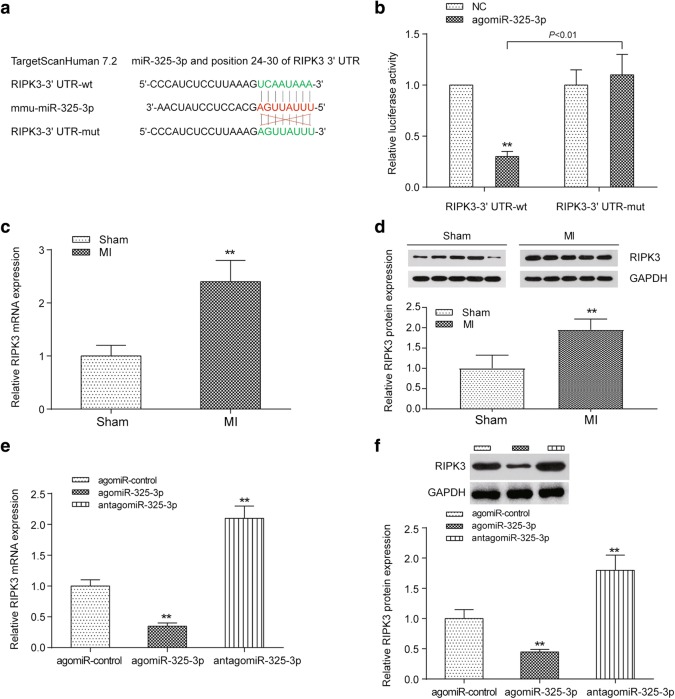Correction to: BMC Molecular Biol (2019) 20:17 10.1186/s12867-019-0133-z
The original article [1] contains an error whereby Fig. 7 displays incorrect results; the correct version of Fig. 7 can be viewed ahead in this Correction article and should be considered in place of the original article’s version of Fig. 7.
Fig. 7.
Target relationship between miR-325-3p and RIPK3. a The binding sites between the 3′UTR of RIPK3 and miR-325-3p predicted by TargetScanHuman 7.2. b A dual-luciferase reporter assay validated the target relationship between miR-325-3p and the 3′UTR of RIPK3. **P < 0.01 between the wild-type and mutated 3′UTR of RIPK3. c, d The differential expression of RIPK3 mRNA (c) or protein (d) in the sham-operated mice and the MI mice. **P < 0.01 compared to the mice that received the sham operation. e, f The influence of miR-325-3p dysregulation on the expression of RIPK3 mRNA (e) and protein (f) in MI mice. **P < 0.01 compared to MI mice treated with agomiR-control. MI, myocardial infarction; agomiR-325-3p, miR-325-3p agomir; antagomiR-325-3p, miR-325-3p antagomir; agomiR-control, scrambled agomir or antagomir control; RIPK3, receptor-interacting serine/threonine protein kinase 3
Footnotes
Publisher's Note
Springer Nature remains neutral with regard to jurisdictional claims in published maps and institutional affiliations.
Dong-Ying Zhang and Bing-Jian Wang are first co-authors
Reference
- 1.Zhang D-Y, Wang B-J, Ma M, Yu K, Zhang Q, Zhang X-W. MicroRNA-325-3p protects the heart after myocardial infarction by inhibiting RIPK3 and programmed necrosis in mice. BMC Mol Biol. 2019;20:17. doi: 10.1186/s12867-019-0133-z. [DOI] [PMC free article] [PubMed] [Google Scholar]



